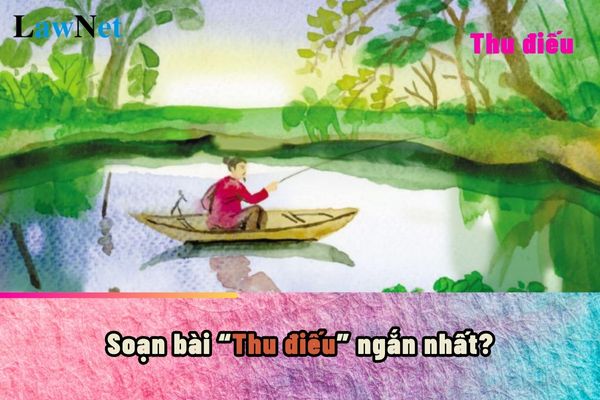What are guidelines on detailed analysis of the poem "Thu điếu" for students in Vietnam? What are general orientations on the educational methods of grade 8 Literature in Vietnam?
What are guidelines on detailed analysis of the poem "Thu điếu" for students in Vietnam?
"Thu điếu" is one of the contents that students will study in the grade 8 Literature. The poem is on pages 40 and 41 of "Kết nối tri thức" curriculum.
Below are guidelines on detailed analysis of the poem "Thu điếu" for students in Vietnam:
|
Detailed analysis of the poem "Thu điếu" * Main content of the poem |
*Note: The guidelines on detailed analysis of the poem "Thu điếu" for students in Vietnam are for reference purposes only./.

What are guidelines on detailed analysis of the poem "Thu điếu" for students in Vietnam? What are general orientations on the educational methods of grade 8 Literature in Vietnam? (Image from the Internet)
What are general orientations on the educational methods of grade 8 Literature in Vietnam?
Based on the General Education Program for Literature, issued together with Circular 32/2018/TT-BGDDT, the general orientations on the educational methods of grade 8 Literature in Vietnam are as follows:
The Literature program applies educational methods oriented towards integrated and differentiated teaching; diversifies organizational forms, methods, and teaching means; promotes the activeness, proactiveness, and creativity in students' learning and application of knowledge and skills.
Based on the program, teachers proactively and flexibly build and organize lessons according to the following orientations:
- Implementing the requirements of intra-subjects integration (both knowledge and skills), inter-subject integration, and integration of prioritized educational content (cross-subject); perform differentiated teaching according to student subjects at all levels and differentiation contributing to career orientation in high school.
- Training students in reading, writing, speaking, and listening methods; practicing and experiencing the reception and application of Vietnamese language and literature knowledge through various learning activities inside and outside the classroom; focusing on using teaching means, overcoming rote teaching, developing thinking, and training students in using the means.
- Enhancing and promoting the activeness and autonomy of students; dedicating more time for students to research textbooks and learning materials, practice, present, discuss, and defend their learning outcomes so that students know how to read, write, speak, and listen according to different requirements and levels; checking and assessing the performance of students' learning tasks.
What are required competencies in reading comprehension in the grade 8 Literature program in Vietnam?
Based on Section IV of the General Education Program for Literature, issued together with Circular 32/2018/TT-BGDDT, the required competencies in reading comprehension in the Grade 8 Literature program are as follows:
READING
READING COMPREHENSION
Literary texts
Understanding the content
- State the overall content of the text; recognize typical details, themes, stories, characters in the entirety of the work.
- Recognize and analyze the theme, ideology, and message the text wants to send to the reader through the artistic form of the text; analyze some bases to determine the theme.
- Recognize and analyze the feelings, emotions, and main inspiration of the writer expressed through the text.
Understanding the form
- Recognize and analyze the role of imagination in receiving literary texts.
- Recognize some elements of satirical stories, historical stories such as: plot, context, characters, language.
- Recognize and analyze single and multi-line plots.
- Recognize and analyze the effects of some main artistic devices of satirical poetry.
- Recognize some poetic rules of seven-character eight-line poems and quatrains of Tang poetry such as: structure, niêm, luật, rhyme, rhythm, and parallelism.
- Recognize and analyze the uniqueness of the poem through words, images, structure, emotional flow.
- Recognize and analyze some elements of comedy such as conflict, action, characters, dialogue, satirical devices.
Connecting, comparing, and linking
- Understand that each reader may have their reception of a literary text; respect and learn from others' receptions.
- Comment on the content reflecting and the author's perspective on life and people in the literary text.
- State changes in thoughts, feelings, or ways of living after reading a literary work.
Extended reading
- In one school year, read at least 35 literary texts (including texts guided to read on the internet) with genres and lengths equivalent to the texts studied.
- Memorize some excerpts or favorite poems in the program.
Argumentative texts
Understanding the content
- Recognize the thesis, main points, reasoning, and prominent evidence in the text.
- Analyze the relationship between the thesis, main points, reasoning, and evidence; the role of main points, reasoning, and evidence in expressing the thesis.
Understanding the form
- Differentiate between objective reasoning and evidence (verifiable) and subjective opinions and evaluations of the writer.
Connecting, comparing, and linking
- Connect the content mentioned in the text with current social issues.
Extended reading
- In one school year, read at least 9 argumentative texts (including texts guided to read on the internet) with lengths equivalent to the studied texts.
Informational texts
Understanding the content
- Analyze the basic information of the text.
- Analyze the role of details in presenting the basic information of the text.
Understanding the form
- Recognize and analyze characteristics of some types of informational texts: texts explaining a natural phenomenon; texts introducing a book or movie watched; point out the relationship between text characteristics and its purpose.
- Recognize and analyze the way of presenting information in the text by chronological order, cause-and-effect relationship, the importance of objects, or comparison and contrast.
Connecting, comparing, and linking
- Connect information in the text with contemporary social issues.
- Evaluate the effectiveness of a non-verbal means in a specific text.
Extended reading
- In one school year, read at least 18 informational texts (including texts guided to read on the internet) with types and lengths equivalent to the studied texts.

